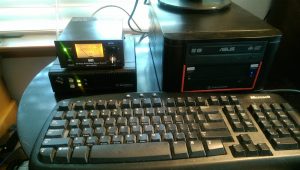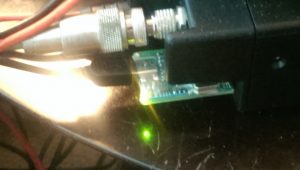 Ok, so a few posts ago, I lamented about how EchoLink was sorta boring. And because I felt that way, I undertook a project to evolve my traditional Windows based EchoLink node to an AllStarLink node (with an EchoLink channel!)
Ok, so a few posts ago, I lamented about how EchoLink was sorta boring. And because I felt that way, I undertook a project to evolve my traditional Windows based EchoLink node to an AllStarLink node (with an EchoLink channel!)
Well, after a couple of weeks of learning AllStarLink, and sorting out a malfunctioning interface module, it’s finally up and running and by all accounts it sounds really great! And before I go any further, I want to give my sincere thanks to Scott Zimmerman (N3XCC) of Repeater-Builder fame who built and supplied the modules I used and for his help in sorting out the bad module. Scott is a great guy and a stand-up businessman and I would highly recommend his products! I used the RIM-Maxtrac-RM (correction: I used the RB_RIM_Maxtrac interface! Thanks Scott!) version of his line which can be found at http://www.repeater-builder.com/products/usb-rim-lite.html . This module has a 16 pin connector that plugs directly onto the back of the Motorola Maxtrac radio that I was using for the EchoLink node. A picture of this module can be seen on the left below and as the lower left image and the middle image of the 5 images at the top of Scott’s product page.  The module provides a nice, compact audio and control interface to the computer in a single USB connection. I used the most recent DIAL image for installing AllStarLink on the computer, and was actually up and running fairly quickly (if you take out the time we spent sorting out the bad module.)
The module provides a nice, compact audio and control interface to the computer in a single USB connection. I used the most recent DIAL image for installing AllStarLink on the computer, and was actually up and running fairly quickly (if you take out the time we spent sorting out the bad module.)
I’m really quite amazed at the flexibility and programmable control one can have using the AllStarLink system. It’s designed to be a full fledged repeater controller and repeater linking system. The default audio quality AllStarLink uses is quite a bit better than I imagined. Even the EchoLink connections sound better to me than they did before! As a bonus, the streaming audio feed for the repeater to which the radio is tuned now originates directly out of the AllStarLink node. The quality improvement of this alone made the entire project worthwhile!
I invite you to check out the node if you like! On AllStarLink it is node number 43758 and on EchoLink it is still node N0NOE-R (407714.) The radio is tuned to the input and output frequencies of the Sullivan Amateur Radio Club 2 meter repeater which is located in West Sullivan, MO and is on 146.805 Mhz.
« Just when you think you know what’s going on… AllStar Link Presentation at the SARC Meeting »





The repeater project is coming along quite well. It is on the air currently at 28ft. Repeater is a Kenwood TKR-820 using an FFsystems FF-800 controller with 3.11 F/W. The controller is really awesome, it has five ports and is very customizable.
Since internet is horrible here, I have bought two CDM1550LS+ 220 link radios. I will put one at another ham’s house (who has good internet) along with an HP Thinclient running Allstarlink. The repeater-builder USB RIM lite looks like the easiest way to interface the CDM1550 for allstarlink. The other one will be tied into the repeater controller and will have a 220 yagi pointed in toward wherever the internet link radio will be. That is the only solution I’ve really found for getting internet linking on my repeater.
The repeater antenna will eventually be on a tower, we have dug a hole for the concrete base however it probably won’t be until spring of 2017 that we get the concrete poured.
Currently I’m hexediting the CPS for the CDM1550’s and trying to move them to the ham band. Although the guys on batlabs say you have to hexedit the codeplug and use the Russian Waris lab software, I have found a way to edit the RUI41 DLL file and the ProRadio CPS itself so that it will program the radio out of band.
If you’re working on building a couple repeaters, I’d highly recommend a Kenwood TKR-720 or 820. They have great RX sensitivity and are easy to interface.
Also, if you know anyone who has a DB products UHF commercial/repeater that they’re looking to sell, let me know. I need one to put on the tower. I was originally looking at a Diamond F718A, but it appears to have multiple issues.
Joe has decided to use a Signalink to interface his GM300 for echolink use. I guess that’ll work, but I have had no experience using Signalinks.
73,
Jacob AD0JA
Glad to hear your experience is going well. Love the RIM Lites. Using one for the current AllStar node here that talks to the .805 machine. Also purchased a new one for the Rpi3 based controller I just built to replace the current controller on that machine. With any luck, the new controller will be in place in the next couple of weeks.
One of the repeater projects we’re undertaking here in Owensville is a 2 meter TKR-720. I’m curious if you found someone to program it for you, or if you used the brute force method defined on Repeater Builder? We’re attempting the brute force method, but I think if I had to do it all over again, I would have just found someone to program it for me. My intention is to use another Rpi3 and RIM Lite as the controller on that machine. The other Owensville repeater project is going to be a UHF machine using two Motorola radios, a third Rpi3 and the repeater version of the RIM Lite. Both of those projects are moving very slowly here, but I guess that’s ok since we haven’t totally settled on a site for them. I’d like to co-locate them so we don’t have to solve the tower problem more than once.
Bill,
Just wondering how you fixed the issue with low echolink TX audio on the Maxtrac? I am helping my friend Joe, KD0VKG find a Echolink interface for his GM300 and was going to recommend a Rigblaster, but the TX audio is very low.
I guess N3XCC’s RB RIM won’t work with Windows echolink?
73
Jacob ad0JA
I found that I had to put a better sound card into the PC. My initial attempt was to use the sound device on the motherboard and I had marginal success with that. I then upgraded the PC with a Sound Blaster Audigy FX and the quality of the audio (and its volume as well) were greatly improved.
I don’t know for sure, but the RB RIM is specifically designed to work with AllStar Link. It is, however, just a USB Sound card, so it might work with EchoLink, but you would need a way to specify to EchoLink the control lines for PTT and COR. I don’t know if there’s an easy way to do that.
How are your repeater building experiences going? I have four repeater projects on my plate now. We’re soon going to be converting the SARC 2 meter repeater to use an AllStar Link controller and probably building an AllStar Link simplex node tuned to the club’s 440 repeater frequencies. In addition, I have commitments from two friends to assist in building a 2 meter and a 440 machine in or around the Owensville area.